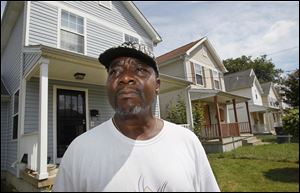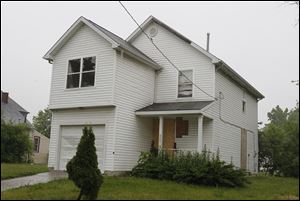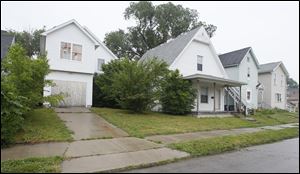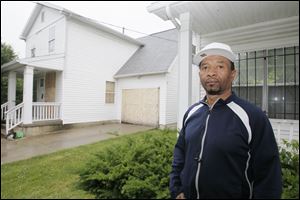
BLADE INVESTIGATION
Taxpayer-aided homes sit vacant, vandalized
$114M went to program in Toledo
6/24/2012
ONYX board President WilliAnn Moore, a former head of the NAACP in Toledo, did not respond to calls for comment.
The Blade
Buy This Image
One in a series

Zettie Williams lives in the last occupied house built by the Warren-Sherman Area Council on the 2200 block of Kent Street. Seven houses were built on the street.
During the last 15 years, community development groups in Toledo received $114 million in taxpayer assistance to build more than 800 new houses for low-income residents on vacant lots in Toledo.
A Blade investigation found more than one sixth of those homes are now vacant. Of those, 102 are boarded up, gutted, or burned out, contributing to blight rather than combatting it.
The houses are part of a federal low-income housing tax credit program administered by the state, and they received massive amounts of taxpayer help. The 819 houses in Toledo, most of which were brand new, received more than $100 million in tax credits, which developers sell at steep discounts to big corporations to raise money for their projects. While not a direct subsidy, the tax credits represent money that corporations would have otherwise paid to the IRS.

This house at 827 Vance St. is one of the recently built dwellings that now sits vacant and boarded up, with the front-yard shrubbery overgrown.
In addition to the tax credits, the houses received $13 million in other types of government assistance, mostly federally funded state and city loans that are later forgiven.
That translates to an average public subsidy of $140,000 per house, which means the boarded-up houses represent a loss of roughly $14 million in taxpayer money.
'I refuse to leave'
Zettie Williams' home has become an island.
Its manicured lawn, carefully tended flowers, and Pittsburgh Steelers pennant on the front porch stand in stark contrast to their surroundings. Of the seven tax-credit homes built on the 2200 block of Kent Street in 1997, it's the only one that remains occupied.
The other homes have boards covering their windows and doors, and vandals stripped some siding from one house, Mr. Williams said.
It's all quite different from the original vision of the nonprofit developer, the Warren Sherman Area Council, which received $5.3 million in tax credits and $778,000 in state and local aid to build 55 mostly new houses in the near-downtown neighborhood close to Bancroft and Cherry streets.
"It's going to change the whole face of the community," said Bob Price, executive director of Warren Sherman, during the project's ground breaking in 1997.
Today, 21 of the houses are boarded up. Many have been completely gutted by vandals, who have ripped out everything from electrical wiring to kitchen sinks.
This month, Mr. Williams, a board member of the Warren Sherman Area Council, stood in his front yard -- now surrounded with a chain link fence he installed at his own expense -- and placed blame squarely on poor management and leadership by the Warren Sherman council.
Other residents agree.
Marilyn Kelley, who has lived around the corner on Sherman Street for six years, said she had to wait months to have her home repaired after a huge portion of siding was torn off by high winds, and her daughter's room has mold in it from a leak in the roof.
Despite his status as the last man standing on Kent Street, Mr. Williams said he plans to stay.
"I refuse to leave," he said. "No one's gonna run me outta here."
Poor upkeep
The dire condition of the Warren Sherman project is not unusual among Toledo's single-family-home tax-credit projects. Of the 21 ventures built in Toledo since 1997, six have vacancy rates of a quarter or more.

A recently built house on Avondale Avenue is vacant and boarded up, in contrast to nearby older structures, which are occupied.
Toledo Homes I and II -- two projects developed by Organized Neighbors Yielding Excellence, or ONYX -- consist of 86 houses in the neighborhood east of downtown and south of Dorr Street.
As with other tax-credit projects, the houses must be rented to low-income tenants for 15 years, after which occupants are supposed to have the opportunity to purchase the houses at below-market prices. Toledo Homes I is the only project to reach the 15-year threshold, but so far none of the homes has been sold.
Instead, 32 of the houses in Toledo Homes I and II are boarded up, and a neighbor confirmed another is vacant. Nine have code-violation notices posted on their front doors, declaring them "an immediate hazard or danger to the health, safety, or welfare of an individual or community." One house is nothing but a burned-out shell.
Another features a large hole in the living room drywall, from which a cat emerged as a reporter knocked on the door.
Altogether, ONYX's boarded-up homes represent a loss of about $4.3 million in taxpayer investment.
Johnnie Barringer, who lives next door to a boarded-up ONYX house on Tecumseh Street, said the blight has contributed to crime in the neighborhood. He once watched a thief steal the next-door neighbor's garage door. He's endured several break-ins at his own house too. His house is now outfitted with a security system and bars on the doors and windows.
"The trees and the bushes have grown out of control," Mr. Barringer said. "It could be a hiding spot for someone. That's a problem for anyone in the neighborhood."
Despite numerous phone calls, ONYX has "done absolutely nothing about the problem," he said.
"I've enjoyed living here, but it's poor upkeep," said Brenda Johnson, who has lived in an ONYX home on Hildebrand Street since 2006. "All they do is collect the rent."
'These are hard times'
ONYX's story provides insight into why the relatively new houses have fared so poorly.

Johnnie Barringer, who lives next to a boarded-up ONYX house on Tecumseh Street, says the blight has contributed to crime in the area. He has installed a security system and bars on his doors and windows.
Once one of Toledo's most prominent community development organizations, ONYX has received hundreds of thousands of dollars in city-administered Community Development Block Grant funds since it was founded in 1987. The group's former executive director, Jimmy Gaines, was paid $68,987 annually, according to its 2010 tax return, the most recent available. Mr. Gaines came to ONYX after retiring as a top city administrator.
With Toledo Homes I, ONYX pioneered the city's first single-family federal low-income tax credit housing project. When ONYX broke ground in 1995, Aaron Laramore, then the group's executive director, hailed the project as "the beginning of the turnaround of the central city."
But almost immediately, the project experienced problems. In 1996, the city had to give the project a $53,000 cash infusion for unanticipated infrastructure work. Then, in 1998, a year after residents moved in, sewage backups plagued some of the houses.
In 2007, a new property manager, the Renee Co., was hired but things only got worse, according to a lawsuit ONYX filed against the firm.
The company's owner, Kimberly Dobson, collected rents but failed to disburse them, allowed one of her employees to live in a house rent-free for more than a year, diverted checks from the Lucas Metropolitan Housing Authority to an undisclosed account and used the funds for herself, diverted money from Toledo Homes' account to another housing project, failed to pay taxes and utility bills, and did not make payments on the mortgage, according to allegations in county and federal court records.
When ONYX took over the properties from Renee Co. in 2009, it found that the occupancy rate had dropped to 46 percent from 95 percent, according to court records. Ms. Dobson later filed bankruptcy.
In a phone interview, Ms. Dobson called the lawsuit frivolous. She acknowledged that the number of vacant units grew under her tenure, but she said that was because the project didn't have enough money to make necessary repairs after tenants moved out.
"When I took over, they were being sued by a number of creditors," she said. "It was a headache from the time I took the property on. All these problems existed before I took them on."
The lawsuit against Ms. Dobson is on hold because Charter One Bank has requested the federal court appoint a receiver for the properties.
Ms. Dobson also acted as a property manager for Warren Sherman. That organization sued Ms. Dobson for similar reasons, but settled out of court.
ONYX board President WilliAnn Moore, a former president of the Toledo chapter of the NAACP, did not return phone calls from The Blade.
Margaret Brown, executive director of Warren Sherman Area Council, said the poor economy is to blame for nearly 40 percent of the houses developed by the organization being vacant.
"These are hard times," she said. "People are losing their jobs, having their wages cut, and that impacts how they pay their bills."
'Heartbreaking'
Hugh Grefe, executive director of the Toledo affiliate of Local Initiatives Support Corp., or LISC, called the experiences of ONYX and some other community development organizations heartbreaking.

ONYX board President WilliAnn Moore, a former head of the NAACP in Toledo, did not respond to calls for comment.
But much of it was of their own making, he said.
LISC has spent hundreds of thousands of dollars -- a combination of private and federal funds -- to send local community development leaders to training sessions here in Toledo and to out-of-town events. "Some groups used the training well," he said. "Other groups would be happy to do the training, but they didn't apply it."
Once, LISC paid for an expensive software tool to help development organizations better manage their properties. "We later suspected some of them never put the disc in the machine based on the questions they'd ask us and the trouble they'd get in," he said.
Mr. Grefe and others also suggested some groups may have been motivated by factors other than the well-being of their neighborhoods. Developers, in this case the local community development groups, received large development fees -- $434,471 per project on average.
"For every one that failed, staff didn't internalize their own duty," Mr. Grefe said. "They saw the potential for PR, the developer fee, and the prestige, but they didn't roll up their sleeves and do the hard work of properly managing their properties."
Mike Beazley, president of the Lucas County Land Bank, put it this way: "I think they are motivated by an effort to improve neighborhoods. Among their challenges is staying viable as organizations. It's got to be something they think about. … We've got to ask the question 'Should we? Not just can we?' "
Mr. Grefe said some groups have failed to maintain their reserves and contingency funds as well -- money that could have been used to renovate houses that have fallen into disrepair.
Indeed, records show that ONYX sought to use funds for construction that are normally set aside for contingency. In a 1996 letter from Mr. Laramore to the Ohio Department of Development, the nonprofit group's director begged for permission to use $300,000 in state funds "to support the hard construction cost line item, not as contingency." The state granted Mr. Laramore's request, which allowed ONYX to obtain a larger commitment from its tax credit investors, but also reduced the amount of money the organization had on hand to deal with unexpected problems.
By 2009, records show ONYX had fallen $30,000 behind on its mortgage payments to Charter One Bank, requiring a bailout from National Equity Fund, the LISC-affiliated broker between ONYX and the investors who received the tax credits. As of the end of 2010, ONYX had revenues of $264,262 and expenses of $351,628, with a $51,366 deficit, according to its most recent available tax returns. Reserve funds held by ONYX kept the deficit from being larger.
Role of politics
Politics have also played a role in propping up poor-performing groups.
The city continued to fund ONYX with community block grant money even as it issued scores of nuisance violations for its inadequately maintained tax-credit homes. During the last five years, the city gave the group more than $300,000 in federal block grant funds.
Last year, the city's block grant review committee recommended no funds for ONYX, but city council still awarded the group $90,000 -- a testament to the group's political clout, some say.
ONYX never actually received the funds because it did not provide a required audit or complete planned activities, according to Lourdes Santiago, director of the city's neighborhoods department.
The group is not recommended to receive any funds for the upcoming fiscal year, which begins in July. "We cannot provide them funds if the organization is not performing," Ms. Santiago said.
In addition to angering neighbors and wasting taxpayer subsidies, the blighted state of many of the tax credit projects has been a significant drain on the city's coffers.
Nearly all of the 102 boarded-up tax credit houses have received multiple code violation notices. The violations include tall grass and weeds, junk and debris in yards, flaking paint, downed gutters, broken windows, and missing siding. Some are more serious.
One housing code order for a Toledo Community Development Corp. home on Norwood Avenue required the group to replace or repair floors, ceilings, walls, doors, windows, faucets, sinks, tubs, water heater, and electrical fixtures. Many files indicate that city workers had to board up homes, cut the grass, and remove graffiti.
Mayor Mike Bell estimated that such activities related to tax credit houses have cost the city more than $100,000.
"Even though they were designed to be something positive, some of these houses are draining taxpayer money," he said.
So why did city council vote in favor of funding ONYX last year, despite its dismal performance?
"Politics," the mayor said. "Pure and simple. Why else when you have a recommendation saying these agencies shouldn't be given money based on their performance would you give them money anyway?"
Contact Kate Giammarise at: kgiammarise@theblade.com or 419-724-6091.